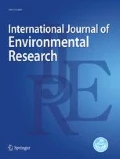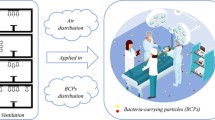Abstract
The aim of this study was to assess the impact of ventilation and filtration conditions on particle concentrations in an orthopedic operating room. Total particle, viable particle, and CO2 concentration were measured under three different situations, namely before air filter replacement, after air filter replacement, and in an operating room with a new air conditioning system. Before air filter replacement, the mean values of airflow, total particle concentration, and viable particle concentration were 706 m3/h, 15.0 × 106 ± 4.0 × 106 particles/m3, and 57 CFU/m3, respectively. After replacement, the airflow increased to 1954 m3/h, and total and viable particle concentrations decreased to 0.4 × 106 ± 0.2 × 106 particles/m3 and 24 CFU/m3, respectively. In the room with a new air conditioning system, the airflow was 2051 m3/h, and total and viable particle concentrations were 0.3 × 106. ± 0.1 × 106 particles/m3 and 15 CFU/m3, respectively. The CO2 levels were 663 ppm (before), 659 ppm (after), and 574 ppm (new room). The results showed that inappropriate or no maintenance of filters in an air conditioning system had significant negative effects on indoor air quality in operating rooms. Air conditioning systems operating with saturated filters can be affected by pressure drop, which can lead to a reduction in airflow, thereby resulting in an increase in the average total particle and viable particle concentrations and the risk of infection in operating rooms. However, the results showed that the CO2 concentration was not affected by the filter replacement.
Article Highlights
-
Improper maintenance of the air filters poses negative effects in operating rooms.
-
Particles remain inside the room with less air exchange caused by saturated filters.
-
Change in filters produces a greater effect on air quality in operating rooms.
-
CO2 concentration generated by the people may not be affected by the filter replacement.



Similar content being viewed by others
References
Nbr ABNT (2005) Air conditioning for health care facilities - Requirements for design and installation. Standard 7256:2005
Alsaleem F, Munroe M, Rafaie M (2016) Current based HVAC systems air filter diagnostics and monitoring. In: 4th International High Performance Buildings Conference at Purdue, July 11–14, 2016.
Andersen AA (1958) New sampler for the collection, sizing, and enumeration of viable airborne particles. J Bacteriol 76(5):471–484
ASHRAE (2019) Ventilation for acceptable indoor air. Atlanta: American Society of Heating, Refrigerating and Air-Conditioning Engineers. Standard 62: 2019.
Becker K, Heilmann C, Peters G (2014) Coagulase-Negative Staphylococci. Clin Microbiol Rev 27(4):870–926
Beggs CB (2003) The Airborne Transmission of Infection in Hospital Buildings: fact or fiction? Indoor Built Environ 12:9–18
Botelho AM, Nunes ZD, Asensi MD, Gomes MZ, Fracalanzza SE, Figueiredo AM (2012) Characterization of coagulase-negative Staphylococci isolated from hospital indoor air and a comparative analysis between airborne and inpatient isolates of Staphylococcus epidermidis. J Med Microbiol 61:1136–1145
Centres for Disease Control and Prevention (CDC) (2003) Guidelines for environmental infection control in health-care facilities. Atlanta, U.S. Department of Health and Human Services Centres for Disease Control and Prevention.
Chow TT, Yang Y (2004) Ventilation performance in operating theatres against airborne infection: review of research activities and practical guidance. J Hosp Infect 56(2):85–92
Cole EC, Cook CE (1998) Characterization of infectious aerosols in health care facilities: an aid to effective engineering controls and preventive strategies. Am J Infect Control 26:453–464
Dallolio L, Raggi A, Sanna T et al (2017) Surveillance of environmental and procedural measures of infection control in the operating theatre setting. Int J Environ Res Public Health 15(1):46
Dascalaki EG, Lagoudi A, Balaras CA, Gaglia AG (2008) Air quality in hospital operating rooms. Build Environ 43:1945–1952
Dharan S, Pittet D (2002) Environmental controls in operating theatres. J Hosp Infect 51(2):79–84
Dolinger EJ, Brito DV, Souza GM, Melo GB, Gontijo Filho PP (2010) Air contamination levels in operating rooms during surgery of total hip and total knee arthroplasty, hemiarthroplasty and osteosynthesis in the surgical center of a Brazilian hospital. Rev Soc Bras Med Trop 43(5):584–587 ((article in Portuguese))
Edmiston CE Jr, Seabrook GR, Cambria RA, Brown KR, Lewis BD, Sommers JR (2005) Molecular epidemiology of microbial contamination in the operating room environment: Is there a risk for infection? Surgery 138:573–582
Fernstrom A, Goldblatt M (2013) Aerobiology and itsrole inthe transmission of infectious diseases. J Pathog 2013:493960
Fisk WJ, Faulkner D, Palonen J, Seppanen O (2002) Performance and costs of particle air filtration technologies. Indoor Air 12(4):223–234
Gallo J, Kolar M, Novotny R, Rihakova P, Ticha V (2003) Pathogen Prosthes-Relat Infect Biomed Papers 147:27–35
Gormley T, Markel TA, Jones H, Greeley D, Ostojic J, Clarke JH, Abkowitz M, Wagner J (2017) Cost-benefit analysis of different air change rates in an operating room environment. Am J Infect Control 45(12):1318–1323
Gosden PE, MacGowan AP, Bannister GC (1998) Importance of air quality and related factors in the prevention of infection in orthopaedic implant surgery. J Hosp Infect 39:173–180
Hanley JT, Esnor DS, Smith DD, Sparks LE (1994) Fraction aerosol filtration efficiency of in-duct ventilation air cleaners. Indoor Air 4:169–178
ISO/IEC – International Organization for Standardization/International Electrotchnical Commission. GUM 98–3. Guide to the expression of uncertainty in measurement. 2008.
Jamariska M, Morawska L, Clark BA (2000) Effect of ventilation and filtration on submicrometer particles in an indoor environment. Indoor Air 10(1):19–26
Karthikeyan CP, Samuel AA (2008) CO2-dispersion studies in an operation theatre under transient conditions. Energy Build 40:231–239
Landrin A, Bissery A, Kac G (2005) Monitoring air sampling in operating theatres: can particle counting replace microbiological sampling? J Hosp Infect 61:27–29
Maus R, Goppelsroder A, Umhauer H (2001) Survival of bacterial and mold spores in air filter media. Atmos Environ 35:105–113
Memarzadeh F, Manning AP (2002) Comparison of operating room ventilation systems in the protection of the surgical site. ASHRAE Trans 108(2):3–15
Milisavljevic V, Wu F, Cimmotti J, Haas J, Della-Latta P, Larson E et al (2005) Genetic relatedness of Staphylococcus epidermidis from infected infants and staff in the neonatal intensive care unit. Am J Infect Control 33:341–347
Mirhoseini SH, Nikaeen M, Khanahmd H, Hatamzadeh M, Hassanzadeh A (2015) Monitoring of airborne bacteria and aerosols in different wards of hospitals—particle counting usefulness in investigation of airborne bacteria. Ann Agric Environ Med 22(4):670–673
Monsen T, Karlsson C, Wistro MJ (2005) Spread of clones of multidrug-resistant, coagulase-negative Staphylococci within a university hospital. Infect Control Hosp Epidemiol 26(1):76–80
Morawska L, Jamriska M, Francis P (1998) Particulate matter in the hospital environment. Indoor Air 8:285–294
Morawska L (2006) Droplet fate in indoor environments, or can we prevent the spread of infection? Indoor Air 16:335–347
Nimra A, Ali Z, Khan MN, Gulshan T, Sidra S, Gardezi JR, Tarar MR, Saleem M, Nasir ZA, Colbeck I (2015) Comparative ambient and indoor particulate matter analysis of operation theatres of government and private (trust) Hospitals of Lahore, Pakistan’. J Anim Plant Sci 25(3):628–635
Nogler M, Krismer M, Haid C, Ogon M, Bach C, Wimmer C (2001) Excessive heat generation during Cutting of cement in the Robodoc hip-revision procedure. Acta Orthop Scand 72(6):595–599
Offermann FJI, Loiselle SA, Sextro G (1992) Performance of air cleaners in a residential forced air system. ASHRAE J 34(7):51–57
Pereira ML, Vilain R, Leivas TP, Tribess A (2012) Measurement of the concentration and size of aerosol particles and identification of the sources in orthopedic surgeries. HVAC&R Res 18(4):588–601
Pereira ML, Vilain R, Galvão FHF, Tribess A, Morawska L (2013) Experimental and numerical analysis of the relationship between indoor and outdoor airborne particles in an operating room. Indoor Built Environ 22(6):864–875
Pereira ML, Knibbs LD, He C, Grzybowski P, Johnson GR, Huffman JA, Bell SC, Wainwright CE, Matte DL, Dominski FH, Andrade A, Morawska L (2017) Sources and dynamics of fluorescent particles in hospitals. Indoor Air 27(5):988–1000
Roberts K, Hathway A, Fletcher LA, Beggs CB, Elliott MW, Sleigh PA (2006) Bioaerosol production on a respiratory ward. Indoor Built Environ 15(1):35–40
Sagi HC, DiPasquale T, Sanders R, Herscovici D (2002) Compressed-air power tools in orthopaedic surgery: exhaust air is a potential source of contamination. J Orthop Trauma 16(10):696–700
Simmons RB, Crow SA (1995) Fungal colonization of air filters for use in heating, ventilating, and air conditioning (HVAC) systems. J Ind Microbiol 14:41–45
Simmons RB, Price DL, Noble JA (1997) Fungal colonization of air filters from hospitals. Am Ind Hyg Assoc J 58:900–904
SPSS (2015) SPSS for windows. Version 16.0. SPSS Inc., Chicago
Stetzenbach LD, Buttner MP, Cruz P (2004) Detection and enumeration of airborne contaminants. Curr Opin Biotech 15(3):170–174
Vonci N, Marco MF, Grasso A, Spataro G, Cevenini G, Messina G (2019) Association between air changes and airborne microbial contamination in operating rooms. J Infect Public Health 12(60):827–830
Yang L, Braun JE, Groll EA (2007) The impact of evaporator fouling and filtration on the performance of packaged air conditioners. Int J Refrig 30(3):506–514
Zoon WAC, Van Der Heijden MGM, Loomans MGLC, Hensen JLM (2010) On the applicability of the laminar flow index when selecting surgical lighting. Build Environ 45(9):1976–1983
Acknowledgements
The authors would like to thank Eng. Tomaz Pulga from the Orthopedics and Traumatology Institute of São Paulo for his immense support. Marcelo Luiz Pereira would like to thank the International Laboratory for Air Quality & Health (ILAQH), Queensland University of Technology (QUT), where he was a visiting fellow.
Author information
Authors and Affiliations
Corresponding author
Ethics declarations
Conflict of Interest
On behalf of all authors, the corresponding author states that there is no conflict of interest.
Rights and permissions
About this article
Cite this article
Pereira, M.L., Vilain, R., Kawase, P.R. et al. Impact of Filtration Conditions on Air Quality in an Operating Room. Int J Environ Res 14, 685–692 (2020). https://doi.org/10.1007/s41742-020-00286-x
Received:
Revised:
Accepted:
Published:
Issue Date:
DOI: https://doi.org/10.1007/s41742-020-00286-x




